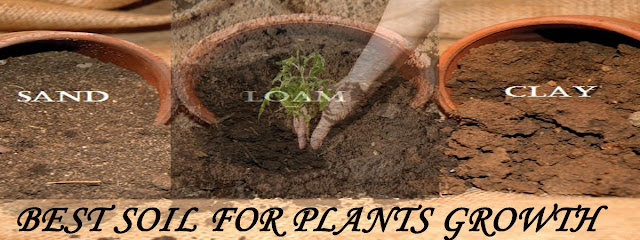Best Soil for the Plants Growth!!!
There are three major classes of soil: SAND, SILT, and CLAY. The best soil for many plants to ensure optimal enlargement is a rich, sandy loam. This soil is an excellent mix of all three main forms of soil.
In most circumstances, you'll be able to wish to amend the soil with compost. Depending on how compact the soil is, you may need to mix peat moss and sand. However, there are lots of plants that are well tailored and can develop particularly varieties of soil.
Different Plants for Different Soils
Soil is generally described through the volume of sand, clay, and silt it contains. This is referred to as texture. Soil texture is immediately related to nutrient high quality and drainage functions.
A loam soil incorporates a pleasant balance of silt, sand, and clay together with humus. The elements that make this soil kind so desirable and good for rising plants include:
• Higher pH level:The perfect pH for most crops are between 6.0 and 7.0. The pH degree impacts the plant's talent to grow. This vary of acidity allows excellent plant vitamins to thrive as well as different soil organisms, such as earthworms.
• Higher calcium degree: Plants need calcium for a healthy growth. Calcium is helping to take care of the stability of soil chemical compounds. It additionally guarantees that water reaches the roots of vegetation by means of improving the soil's ability to retain water.
It additionally contributes to creating the looseness of the soil, so oxygen reaches the roots. Calcium reduces the quantity of salt within the soil. Too much salt damages the root methods and boundaries the plant's enlargement and skill to absorb nutrients.
• Gritty texture:The soil is dry, soft but gritty to the touch, and crumbles simply to provide superb draining properties. The soil texture additionally keeps water and plant vitamins. This benefits the plants with consistent moisture and meals. Since the soil is crumbly, the air flows easily all the solution to the roots.
Sandy Soil
Sand is the most important particle in soil and does now not hang vitamins well.
The following plants are well-adapted to sandy soil.
• Blanket Flower: Drought tolerant, this flower flourishes in nearly pH impartial soil present in sandy soil.
• Adam's Needle: This yucca plant prefers sandy soil and tolerates salt spray. Its roots rot in damp soils.
• Wormwood: This perennial herb is drought-tolerant and prefers dry sandy soils that aren't very fertile.
• Butterfly weed: Attract butterflies with this sun-loving plant that prefers poor, dry sandy soil.
Clay Soil
Soils with a large amount of clay are heavy and do not drain properly. The following crops are well-adapted to clay soil.
• Bee Balm: Some species grow in sandy soils, while others want loamy or clay soils. Check before buying which soil the plant prefers.
• Black-eyed Susan: This flower can grow in a spread of soils from loamy to clay. It needs just right soil drainage, so you may need to amend your flower bed.
• Goldenrod: This wildflower is adaptable to most soil varieties, together with clay.
Silt Soil
Silty soil is powdery with high fertility. Unfortunately, soils which can be high in silt can change into waterlogged very easily. The following crops are well-adapted to silty soil. • Swamp milkweed: This plant thrives in wet soils.
• Yellow iris: This is an adaptable plant. It's great for landscaping around a lawn pond or flow.
• Japanese iris: This flower loves water, so plant it around a garden water characteristic or different wet area.
Best Soil for Flowers:The very best soil to make use of for plants depends upon the type of flower, akin to bulb vs seed, and where you are growing it. For instance, flower bulbs will thrive in sandy loam soil.
• Sandy loam soil provides very good drainage to forestall the bulb from rotting and the roots can grow easily.
• The texture of potting soil is best when planting flowers in a container, similar to a window field or flower pot.
• For a flower garden, you'll use a soil mix of compost, peat, and topsoil as a basic mix with a 1:1:1 ratio.




Comments
Post a Comment